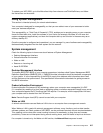
To update your UEFI BIOS, go to this Web site at http://www.lenovo.com/ThinkPadDrivers, and follow
the instructions on the screen.
Using system management
This section is intended primarily for network administrators.
Your computer is designed for manageability, so that you can redirect more of your resources to better
meet your business objectives.
This manageability, or “Total Cost of Ownership” (TCO), enables you to remotely power on your computer,
format the hard disk drive, install the software of your choice (for example, Windows XP with user and
system-management applications), and have the computer start up and function in the same way as an
ordinary desktop PC.
Once the computer is congured and operational, you can manage it by use of software and manageability
features already integrated into the client system and the network.
System management
Check the following topics to learn more about features of System Management:
• Desktop Management Interface
• Preboot eXecution Environment
• Wake on LAN
• Resume on incoming call
• Asset ID EEPROM
Desktop Management Interface
The system BIOS (UEFI BIOS) of your computer supports an interface called System Management BIOS
Reference Specication (SMBIOS) V2.6.1. SMBIOS provides information about the hardware components
of your system. It is the responsibility of the BIOS to supply this database with information about itself
and the devices on the system board. This specication documents the standards for getting access to
this BIOS information.
Preboot eXecution Environment
Preboot eXecution Environment (PXE) technology makes your computer more manageable (it is PXE
2.1-compliant) by enabling it to boot (load an operating system or another executable image) from a server.
Your computer supports the PC functions that PXE requires. For example, with the appropriate LAN card,
your computer can be booted from the PXE server.
Note: Remote Program Load (RPL) cannot be used with your computer.
Wake on LAN
A network administrator can use Wake on LAN to turn on a computer from a management console.
When Wake on LAN is used with network management software, many functions, such as data transfer,
software updates, and Flash updates of UEFI BIOS, can be performed remotely without remote attendance.
This updating can be done after normal working hours and on weekends, to save time and increase
productivity. Users are not interrupted during normal working hours, and LAN trafc is kept to a minimum.
If a computer is turned on by the Wake on LAN function, the Network Boot sequence is used.
Chapter 8. Advanced conguration 217


















